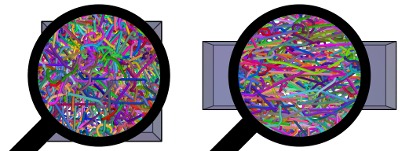 My interests lie in applying state-of-the-art computational techniques to obtain new insights into the fundamental physics of soft-condensed matter. The material properties of such materials are typically due to complex emergent mesoscopic structures. For example, the rendering above is from an topological analysis (primitive-path analysis Science 2004) of the tube structure of a polymer liquid before and after a deformation. By understanding how this tube structures respond to deformation, we can directly observe and learn about the molecular origin of viscoelasticity in polymer materials.
My interests lie in applying state-of-the-art computational techniques to obtain new insights into the fundamental physics of soft-condensed matter. The material properties of such materials are typically due to complex emergent mesoscopic structures. For example, the rendering above is from an topological analysis (primitive-path analysis Science 2004) of the tube structure of a polymer liquid before and after a deformation. By understanding how this tube structures respond to deformation, we can directly observe and learn about the molecular origin of viscoelasticity in polymer materials.
Computer modeling is an ideal technique to study such structure-property relations. We develop coarse-grain models that accurately capture the molecular physics, reproduce the emergent mesoscopic structures and their dynamics, and at the same time allows us to simulate systems that are sufficiently large to allow macroscopic material properties to be measured with good accuracy. With the insights gained from such simulations, we develop a deeper understanding of the fundamental physics of soft-matter, improve state-of-the-art theories, improve analysis of experimental small-angle scattering spectra, and ultimately contribute to the design of new materials with novel properties.